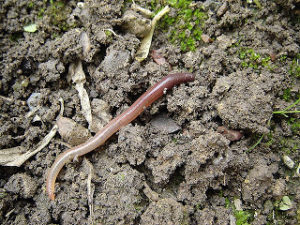
Photo of earthworm, courtesty of “Dodo-Bird”.
There are over 3000 species of worms on the planet. The most common worm that we are familiar with is the earthworm. In scientific terms, earthworms are termed “megadriles” because of their large size. In fact, the earthworm is the largest member of its subclass Oligochaeta. However, earthworms are not the largest worms on earth; some worms can grow to be 22 feet long! These gigantic worms can be found in Australia or South America.
Worms are invertebrates, meaning they do not have a spine. They do however, have a digestive tract, reproductive organs, and multiple hearts. They have an interesting property of regeneration, meaning they can regrow parts of their body should a piece get cut off. A popular belief is that worms will regenerate into two distinct worms if they are cut in half; this is not usually the case. Worms tend to regrow only smaller parts of their anatomy.
Worms benefit humans in many ways; they serve a vital role as oxygen providers, decomposers, and nitrogen builders. Their presence in soil is considered a sign of soil health and vitality. Worms have pliable, moist bodies, which allow them to move through the soil easily. As they move through the soil they eat organic matter, small insects, and bacteria. The tunnels that worms leave in their wake actually aerate the soil, meaning it provides a space for oxygen to access the soil. Finally, the excrement of worms is called a “casting”. Castings are nitrogen rich deposits that enrich the soil and help plants grow.
To learn more about worms, check out the following website: http://www.enchantedlearning.com/subjects/invertebrates/earthworm/Earthwormcoloring.shtml.
It provides a Read and Answer Quiz about earthworms.
Information for this post was found on http://en.wikipedia.org/wiki/Earthworm and the site listed above.
